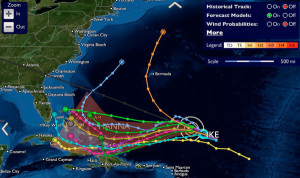
Part 1 by: Tim Helm Director of Security
Last month we spoke about “Being Prepared – Creating a 72 Hour Emergency Kit!” Now we’ll discuss one of the reasons why we should have such an Emergency Kit. Hurricane season will begin on June 1, 2015 and will end on November 30, 2015.
Hurricanes can be tracked by satellite and experts can predict when and where they will make landfall with a great deal of accuracy. This means you have time to evacuate, but it does not necessarily mean you have time to prepare to, “ride out the storm.” Preparations should be an ongoing endeavor in the months leading up to hurricane season.
Many others will have put off preparations until there are warnings and alerts as well. This means the store shelves will be emptied in a matter of hours in some cases and you will likely end up empty handed. The days leading up to the disaster is not the time to try to stockpile enough food and water and get your home ready.
You have to prepare for a hurricane when the threat is not looming. Preparing over time lessens the economic burden and ultimately means you obtain what you need to survive a hurricane.
Preparing Your Home
Many people are convinced they will never leave if a hurricane strikes, they say it year after year and on occasion do manage to stay and survive, while other times pack up the car and leave searching for safer areas inland. Regardless of whether you leave or stay however, you want your home as ready as it can be to survive the onslaught.
Inspect the outside of your home for trees and heavy shrubbery that can damage your home in heavy winds. Trees too close to the home with overhanging branches will cause damage as well as large shrubbery that can thrash against the home. Have a place to move all outdoor furniture inside such as a garage or storage shed. Ensure your storage shed is properly anchored, because if it is thrown against the home it will cause considerable damage.
Consider hurricane shutters that can be shut and secured to prevent debris from breaking through the glass that can cause injuries and allow wind and rain inside your home. Plywood is an option but it is usually not put over the windows until the storm is near and if you do not have a supply on hand, you may not be able to obtain any from local retailers in the days leading up to the storm. Hurricane shutters are typically left on the house to become part of the home’s exterior décor. Ensure the shutters are of good quality and are designed to stop flying debris and tree limbs from smashing the windows.
Tidal surges are a real threat during any hurricane and flooding can occur miles inland, so not only do you have to prepare for wind damage you have to be ready for flooding.
To determine if your area is susceptible to tidal surges and for more information on surges please visit http://www.nhc.noaa.gov/surge/
Stay tuned for Part 2 next month for more Hurricane Preparedness Information. Let’s make sure we are all proactive instead of reactive! Please feel free to contact me should you have any questions or concerns. Stay Safe and Let’s Prepare!


